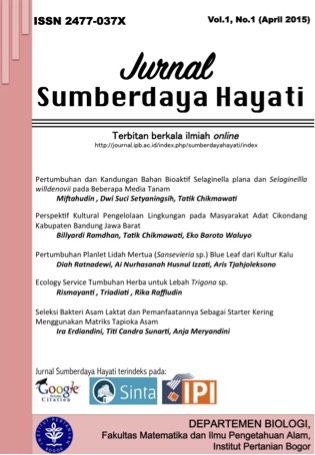Ecology Service Tumbuhan Herba untuk Lebah Trigona sp.
Abstract
Herbaceous plants are able to flower any time, give them opportunity to interact with insects. This study aimed to analyze the diversity of pollen collected by Trigona sp. in herbaceous ecosystem and counted the percentage of pollen viability from the pollen basket. Trigona’s nest was adapted at plot and the herbaceous plants with their pollen were identified. Pollen were took from hind legs at 07.00, 08.00 and 09.00 am. Pollen slide were make by acetolysis and SEM methods. Pollen were identified and examined of viability. Identification herbaceous plants and their pollen on plot showed that there were 7 herbaceous plants: Kyllinga monocephala, Cleome rutidosperma, Pennisetum polystachyon, Ageratum conyzoides, Brachiaria mutica, Cyperus orodatus, and Eleutheranthera ruderalis. Otherwise pollen which were collected by Trigona sp. consist of 11 kinds of pollen from 6 families, that were Sapindaceae, Leguminoceae, Loranthaceae, Malvaceae, Symplocaceae, and unidentified family.Viability of pollen ranged from 88.8% to 99.8%. The result of identification herbacious plants and pollen that were taken by Trigona sp. indicated that there was not similarity therefore, it was no interaction between herbaceous plants in the plot with Trigona sp.
Downloads
Authors who submit and publish with this journal agree to the following terms:
1. Authors retain copyright and grant the journal/publisher non exclusive publishing rights with the work simultaneously licensed under a Creative Commons Attribution 4.0 International License.
![]()
10.3390/d15111149
10.1088/1755-1315/1352/1/012082
10.3389/ffgc.2022.1019994













